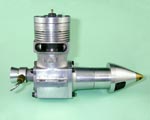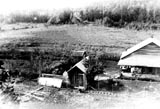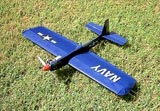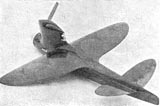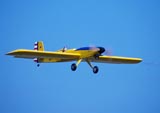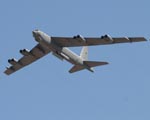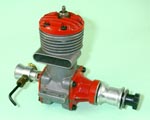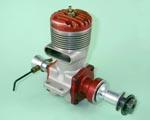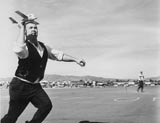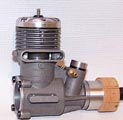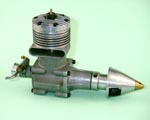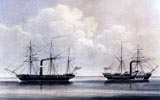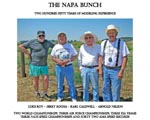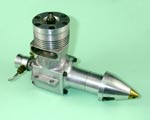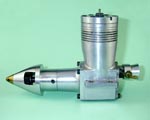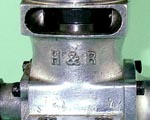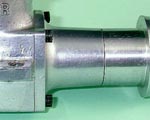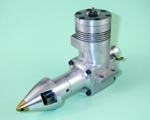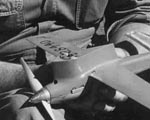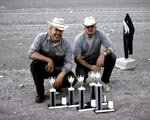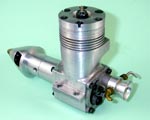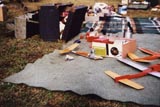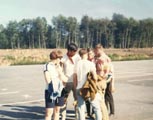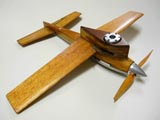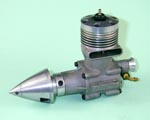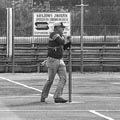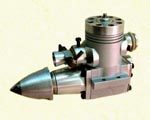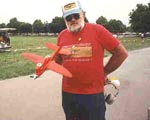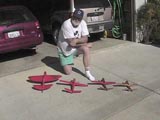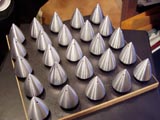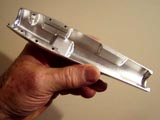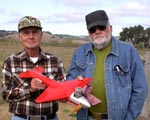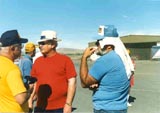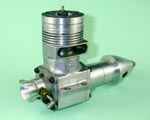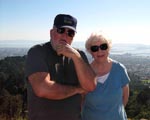The Rattler Story
by Adrian Duncan
In this article we are privileged to present the first-ever in-depth account of the real story behind the creation of one of the truly legendary American racing engines from the 1960's—the H&R Rattler 29. This superb piece of racing equipment was the joint creation of Bill Husted and Luke Roy, who together formed the very successful H&R Speed Team.
Our ability to present this review arises from two fortuitous circumstances. The first is that I'm fortunate enough to be the custodian of a used but still near-pristine example of this very rare engine, thus being in a position to conduct a hands-on examination. The second is that I have been granted the privilege of entering into an extended dialogue with Luke Roy himself, thus being able to present the H&R story from the inside. Bill Husted has unfortunately experienced some health challenges in recent years which have severely restricted his ability to communicate his own input. However, with the much-appreciated help of his wife Kathy, Bill has contributed what he could, while Luke was able to fill in much of the additional detail which Bill might otherwise have supplied.
Luke has been amazingly generous in helping me with the details of this story—details which only he could provide. I'm very happy to think that through this exchange we have become more than colleagues and kindred spirits—we have become friends. My very sincere thanks to Luke for this gift, which is worth far more than any engine.
The story of the H&R Rattler is much more than just another tale about a piece of machinery—it's actually all about the two talented individuals who created it and the guys against whom they competed using it. So let's begin by looking at how Luke Roy became interested in model aircraft and how he came to team up with Bill Husted.
The Road to the Rattler, as Travelled by Luke Roy
Luther (Luke) Roy was born on the 29th of June, 1935 in a rural settlement called New Verda in Grant Parish, Louisiana, along the edges of the Iatt Swamp. This is pronounced "eye-at" and is named after a Native American tribe which occupied this land in the past. They were members of the Caddo Nation. New Verda was then, and is still to this day, the remnant of what was once a pretty successful little sawmill town. The mill shut down in the 1920's and the town has been, in Luke's own words, "slowly disappearing ever since".
Jobs were hard to come by in New Verda during the 1930's. Luke's Dad found little work until America's entry into WW2, after which he had very few days off until the war ended! He worked as a fireman/engineer for the Missouri Pacific Railroad. He lived in a rooming house in Alexandria, Louisiana, while his family lived up in the woods at New Verda. At the end of WW2 he bought a house in Alexandria and moved his family into town.
Luke recalls that when he was about 5 years old (that is, in around 1940), some relatives up in South Arkansas started taking him up to their place during the summers. Luke had a cousin there who was a couple of years older. Their first order of business was generally to go to work building some kind of "stick model" aircraft. As far as Luke can recall, they started one every summer but never finished any of them! Even at that early age, Luke got the message that war was bad news because when Joe Ott came out with his cardboard kits, due to balsa being reserved as a strategic item for life rafts etc, Luke seriously thought that the world had ended!
During these visits, Luke recalls seeing his first gas-powered models. Some other relative in the area had a couple of extra-large free flight models, presumably fitted with Brown Junior engines or similar. Luke remembers their large inflatable balloon tyres. However, as far as he can recall, he never actually saw a free flight model in action until 1951 or 1952.
Following the conclusion of the war and the move into Alexandria, Luke started building models again. He recalls that the town had a pretty good hobby shop, Beason's Hobby. The main modelling activity at the time was control line. Luke learned to fly control line models during the summer of 1950 when he was 15 years old. This was around the start of the Korean War, which resulted in the recall to duty of a lot of ex-WW2 GI's, many of whom showed up in the camps near Luke's hometown. A number of these individuals flew models with the locals at their flying field.
At around this time, Luke got a job at the local airport, pumping gas and carrying out related tasks in return for full-sized flying time. As one might expect, modeling took a back seat for a while! However, just as Luke was about ready to begin flying solo, his Dad was transferred up to a town named El Dorado in South Arkansas, taking the family with him. Now it was the turn of the full-sized airplanes to settle into the back seat! By way of compensation, Luke got in with some pretty capable modellers there and started flying models once again. He began with a series of Veco Warriors, few of which survived the effort to learn to fly inverted, and then moved on to Sterling Ringmasters, which he really liked because you could buy a kit on Friday afternoon and fly it on Sunday afternoon! Most of these met the same fate as the Warriors, but they were cheaper!
Luke and his buddies flew in an area round the back side of the local airstrip. One Sunday after flying, Luke stopped by the office there to get a Coke. While there, he got talking about things in general with the fellow who ran the office. The man finally broke it off, saying that he had airplanes to get into the hangar before dark. Luke helped him with this and was immediately offered a job. Full-sized airplanes were suddenly back in the picture!
The fellow who ran the airstrip bought and sold airplanes as part of his business. After Luke put in a few more hours on the way to his ticket, he got to fly a lot of airplanes that his employer had bought. He worked at the strip for about a year, receiving his Private Pilot's License before joining the US Air Force in 1953 at age 18.
After getting past the universal challenge of surviving basic training, Luke was sent to school at Sheppard AFB, Texas for training as a Heavy Bomber Mechanic. Compared with the basic training schedule, the school schedule represented quite a change. Classes went from 6 am until noon, or from noon until 6 pm, depending on what section one was in. Unless one was stuck with squadron duty, the rest of your time was pretty much your own!
A commercial aviation business was located across the way from the Main Base, using the same runways at Sheppard. One could walk up to a base fire house and call the chief instructor, who would come over and pick up the caller to transport them over to the civilian side. It's pretty obvious that the owner of this operation was politically connected! Luke thus had a congenial place to hang out when off duty. When he had a few bucks to spare (which was not too often at $83 a month!), he would get in an hour or so of flying. On the side, Luke air-lifted Sunday newspapers from Oklahoma City to a couple of towns in Oklahoma and Texas. In this activity he was mostly a glorified helper, but he did build up some multi-engine time as a result. This allowed him to qualify for a Multi Engine rating on his license by passing the check ride fairly easily.
In 1954, Luke was transferred to Travis Air Force Base (AFB) near Fairfield, California. There he worked mainly on B-36 airplanes. In 1956 he was transferred again, this time to Kindley AFB in Bermuda, working on KC-97 tankers. The Base had an aero club with which Luke did a bit of flying using the club airplanes which were kept on the Base. Luke also ran into some modellers flying in the area, which put models once more back into the picture. Since he couldn't get a Ringmaster at the time, Luke built a Sterling Yak-9.
During his earlier model flying activities, Luke had seen a few speed models in action. These had created a strong impression that had stayed with him. Another fellow stationed at Kindley had a Madewell 49 engine and had noted that there was a DeBolt Speedwagon kit in the Base Hobby Shop. Luke bought the kit and the other fellow built it. As far as Luke was concerned, this turned out badly since the fellow built it as designed by Harold DeBolt for clockwise rotation. Luke had always flown the other (normal) way round, so this was an issue.
The first attempts were apparently pretty amusing! The other fellow would run to throw the model, Luke would run to try to fly it. For Luke, the thing was always flying inverted, making him realize the importance of the correct control reversal mindset when flying in that mode! It soon became evident that the model was pretty tough—it needed to be! Luke finally sort of got the hang of it by turning the handle upside down, which worked OK until the engine quit, at which point the mindset issue returned!
Luke reckons that he might still hold the Bermuda National Speed Record to this day—he seriously doubts that anyone has flown a speed model there since. He also doubts that there can be many modellers who can claim that their first speed flight was on the island of Bermuda! My money says that he's right.
In 1958 Luke was transferred back to Travis AFB at Fairfield. At this point he married. The couple lived in a one bedroom apartment in which there happened to be room on the living room floor for the construction of a Veco Chief! So that's where the Chief was built. Until it was completed, it spent its days on the bed and its nights back on the living room floor! Luke's wife Nan was clearly an accommodating spouse; that was, until Luke actually started flying it! At that point, it spent its down-time sitting on the washing machine! Accommodation clearly has its limits, although as of March 2013 Nan had completed 55 years of putting up with Luke's eccentricities!
By 1959 at the age of only 24, Luke had moved up to aircraft crew chief on the B-36. In that year the old B-36's were scrapped and replaced with B-52's. This involved a great deal of work to get them sorted and combat ready. Luke continued as a crew chief, but now on the B-52's. The ongoing workload became far heavier since while the B-36's only flew about once a week, the new B-52's flew 5 times per week.
As he had done in Bermuda, Luke continued flying with the Base aero club at Travis. One evening, Luke went to an aero club meeting on the Base and ran into a fellow crew chief who was there for a model club meeting. This sounded interesting, so Luke bypassed the aero club meeting to attend the model club meet instead. There he met a fellow named Bob Spahr who flew control-line speed. Luke accordingly blames Bob for his long-term addiction to speed flying!
Bob had some molds for a 29 airplane, so some fuselage halves were molded from which Luke built a model around a McCoy 29. There was an Air Force model meet at Travis in 1959, and it was at that event that Luke flew his first speed contest—in fact, his first contest ever.
A few months after this event, Bob Spahr left the service. He went to work for Douglas and flew C-97's for the Air Guard. Luke met up with him several times later when he called in at Travis on his way to or from South East Asia. Later still, the two met again after Luke had got the Rattler 29 working with Bill Husted.
One of the supply techs at Travis was a fellow named Lew Lisch, who had recently returned from Japan, where he had flown a bit of speed. He was a good friend of both Mr Ogawa and Mr Mihara of OS Engines. Mihara-san did a lot of tooling work for OS, especially on the Wankel project. He later went to work for Thunder Tiger.
Lisch and Luke started working together, flying a couple of seasons as members of the Western Associated Modellers, aka WAM. Up to this point, both had been flying two-line airplanes. Lew heard mention of a vacant building on the base that had once been used as a model club shop and might still have some pieces lying around. When he checked this out, the only thing of consequence that he could find was the remains of a Regal Raider proto plane, which was actually a leftover piece from the 1959 meet in which Luke had made his contest debut. It was rigged for mono-line control, so Lew and Luke built a stab, put a rat racer pan and engine in it and used it to learn to fly mono-line. Luke really wishes that he had some video of those early attempts! It took a while to get the hang of the new system, but they both learned.
Enter Bill Husted
Luke believes that it was in 1962 sometime that Lew Lisch called one day to say that a new speed guy had moved into town. So Lew and Luke went over that evening to spend some time with the newcomer, who turned out to be a fellow named Bill Husted. Bill was a firefighter who had formerly been with the State Fire Department stationed at Squaw Valley, California. He had just taken a job as a fireman with the City of Fairfield.
The gentleman who was to become known to the speed modelling fraternity as Bill Husted was born Preston L. Weaver in Shirley, Arkansas on August 18th, 1934. As a member of the Cherokee Nation, he is known as Billy Two Feathers Malone. He has gone by the name Bill for more or less his entire life.
At the age of 6, Bill moved with his mother and step-father to Salem, Oregon. His step-father was a career soldier in the US Army who had actually been in the Army long enough to have been an old-time Horse Soldier. Remarkably, he continued to serve through WW2, finally retiring some time after the war ended.
Bill's memory of December 7th, 1941 is that he was watching a model being flown by some high school students when the news broke about Pearl Harbour. He was seven years old at the time. War or no war, seeing that model fly fairly well installed the desire in Bill to get involved in modeling. His competition debut came several years later at the age of 9, with a speed plane powered by an O&R 23.
In 1947, when Bill was 13 years old, the family moved to Napa, California. There Bill hooked up with a fellow classmate named Karl Caldwell who was very heavily into models, especially speed flying. Initially they were members of a model club called the Napa Gremlins. Later they both flew with another Napa club, the Hells Angels of Napa, a very historic club which boasted some major movers and shakers in the Northern California speed scene. These included the McGowan brothers, Bob Wakerly, Arnold Nelson, Jim Clary, Gordon Wheeler and Floyd Bradford. Apologies from Luke to anyone whom he has missed—no slight intended.
For some time, Bill had been using his step-father's name of Husted, finally changing it legally shortly before he entered the US Air Force in 1952. Trained as a radio teletype operator, he was initially stationed at Alexandria AFB in Louisiana. Attentive readers will recall that this town had been home to his future modelling partner, Luke Roy. However, by the time Bill arrived, Luke had moved up into South Arkansas and visits to Alexandria were rather infrequent. Although Luke was also about to join the US Air Force at this point, their paths did not cross until some years later.
In 1954, Bill was reassigned from Alexandria to Okinawa. There he flew models in several USAF-sponsored model meets and also ran into his old Napa buddy Karl Caldwell at a couple of meets in the Philippines. In those days, each major Air Force command would sponsor a team to come to the Air Force Wide meet in the States at which an Air Force team was selected to go to the US Nationals. Karl was fortunate enough to make this trip a couple of times and hence did a bunch of traveling to major model contests. Bill made it through a couple of levels but was never fortunate enough to get a trip back to the States.
After spending some time serving in Korea, Bill finally came home and was discharged from the Air Force in 1956. He then took engineering classes at Cal Poly for a while, but eventually returned to Napa and became first a State-certified Psychiatric Technician and then later a firefighter at Napa State Hospital. Interestingly enough, this was when another near miss between the two future partners occurred. Readers will recall that Luke Roy had been stationed at Travis AFB about 20 miles from Napa, being transferred from there to Kindley AFB in Bermuda at just about the same time as Bill's return to Napa in 1956. If Luke hadn't been transferred at that time, the two might well have met quite a bit earlier than they did.
Later still, Bill worked as a State firefighter at Squaw Valley and Yuba City, California. He then came to Fairfield as a City Fireman. It was this latter move that resulted in the previously-mentioned 1962 meeting which first brought Luke and Bill together.
When Luke first met Bill, he recognized him immediately as a guy whom he had seen at a WAM meet at Merced the previous year. At that time, Luke had had no idea who he was, but did recall seeing him needling and hand-launching a McCoy 60 speed model (!). These talents of Bill's were to come in very handy for the H&R team in later years. The upshot of this meeting was that the former two-man operation became a three-man effort. The three fliers worked together for another season, again with WAM. Luke and Lew did the flying, while Bill handled the needle setting and launching chores for both.
In July 1962, around the same time as he first got together with Bill, Luke left the Air Force after some nine years of service. He went as a civilian to Mare Island Naval Shipyard in nearby Vallejo, California at the mouth of the Napa River, working initially as an apprentice machinist earning a princely $2.04 an hour on which to support himself, his wife and his son. Doubtless spurred on by this challenging situation, Luke advanced well in the trade, progressively becoming a full machinist, then a toolmaker and finally a die sinker making forging dies. He retired from this position in 1990 at the age of 55. Four days later, Luke was hired by Napa Valley College as an assistant in the Machine Tool Technology Department, where he still works 23 years later as of the time of writing (2013).
Returning to the �60's, in early 1963 Luke was forced to leave the rented house that he had been living in due to the owners returning to town and needing the accommodation themselves. It just happened that at the same time the house next door to Bill Husted in Fairfield came on the market, so Luke bought it. This worked out very well indeed—the two teamed up into what was to become the fabled H&R speed team.
At this time, the financial situations of the H&R team-mates were rather different. As a second year apprentice at the shipyard, Luke was now earning around $2.50 an hour, but Bill was making perhaps ten times that as a City fireman. For Luke, just getting to the end of the month remained a challenge, while Bill had some extra cash available. As a result, the team's early efforts were carried out using equipment owned by Bill as well as being largely financed with Bill's money. Luke contributed a great deal of work while injecting what cash he could. In addition, he managed to sneak a bit of machine time at work, mostly on jigs and fixtures.
Bill had a 6 inch Craftsman lathe and a small relatively cheap drill press. The Craftsman lathe was used both for all turning operations and for the required milling work (using a tool post milling attachment). The drilling fixtures were all used in conjunction with the little drill press. Luke was not comfortable using Bill's lathe since the machine tooling on which he was in training at the shipyard was nothing like Bill's equipment. Accordingly, Bill handled all of the lathe work, while Luke did the drill fixture operations.
Luke recalls that visitors to H&R were often at a bit of a loss when confronted with the very basic machine tooling that they used. Apparently a few visitors actually asked if the "real" machine tools were in Luke's garage! Luke and Bill were polite enough to wait until those visitors left before bursting out laughing! All of the work on the Rattlers was carried out using this basic set-up—it was not until 1968, when the H&R team had been amicably disbanded, that Luke acquired any machine tools of his own. �
In 1962 when they first met, both Bill and Luke were attracted to the 60 class. They pooled resources and wound up with some reasonable McCoys. They were still using a take-off dolly during this period, since Bill had not yet successfully hand-launched a 60-powered airplane on mono-line. This changed when the team went to a WAM contest on the then San Francisco 49'ers practice field. The grass was up around 8 or 9 inches and the dolly wouldn't hack it. They talked it over and decided that if Luke was game to fly it, Bill was game to throw it! Both of them did their part, the result being that the dolly went back home to hang on the wall! The team never again used a dolly in any class of speed flying.
As of early 1963, the Stanzel Mono-Line system was all that was available for single-wire flying. However, speeds were now climbing to levels which were well above the design limits for those units. The result was an ever-increasing incidence of failures. Most fliers simply rebuilt them using updated wire, etc.
The control unit in Luke's 60 plane was slowly but steadily wearing out. Something clearly had to be done. The problem had set Bill Husted to tinkering with a completely different design. The first control unit that the team built together had a ball thrust bearing in a machined frame. It looked promising, so the team built a little profile test model fitted with a sideport Fox .099 engine. This was successfully flown several times, with seemingly promising results.
However, on around the third or so flight, Bill had trouble finding the setting due to dirt in the fuel tank or something of the sort. Luke was in the centre ready to fly, but just about the time when Bill finally hit the setting and was going into his launch routine, Luke saw something flash under the wing. It turned out that this was the flight wire vibrating off the button! Bill didn't see this—he just threw the model and then joined Luke in standing there watching it sail down the field for about 50 yards! Where's the video when you really need it?!?
The next mono-line control unit built by the team was pretty much the model that became the iconoclastic H&R Torque Transfer Unit. This excellent unit is still in use today. Luke reckons that it will outlive both of its creators!
The Rattler Concept Takes Shape
At around this time, Lew Lisch was turning in some pretty good speeds with a front rotary valve (FRV) Super Tigre G21/29. This got the H&R team talking about having more than just the 60 model to fly at contests. It just happened that Luke had a brand new K&B 29R Series 61 sitting on the bench. The team mounted it in a pan and ran it against Lisch's Super Tigre. To their dismay, their engine was at least 5000 revs down on Lisch's motor. Discouraged, they threw that one in the corner for a while.
As well as the Super Tigre undoubtedly ran, Bill Husted was not at all impressed with FRV speed engines. Accordingly, switching to a Super Tigre (like pretty much everyone else at the time) was out of the question. However, the performance of Lisch's Super Tigre had made an impression.
Luke recalls that at the time a flat-top (no baffle) Super Tigre 29 piston and sleeve cost less than 5 dollars. The team bought a couple as think-pieces. Then they remembered the K&B and retrieved it from its corner, tearing it down to see how close the Super Tigre parts would come to fitting. The bore was a couple of thou smaller so they knew that a K&B/Super Tigre hybrid would be legal. The sleeve O/D was about .009 bigger than K&B, so it was possible to jig the case and bore it out to suit. So far, so good.
This was successfully accomplished, immediately facing the team with the question—what should the sleeve timing be? A trip over to Lew Lisch's place to eyeball his Super Tigre gave them the figures, after which they returned home to make the necessary spacer to get the numbers correct in the hybrid. However, it didn't stop there—another WAM member had been playing with a trumpet-shaped head for the Super Tigre. The H&R team acquired one of these heads, having found out that Lew Lisch had been running one and had been keeping rather quiet about it! Luke convinced one of the journeymen at work to grind a form tool to match the sample trumpet head, after which the team cobbled up a similar head for their hybrid project.
The hybrid engine went together OK and was given a few runs on straight FAI fuel. As the engine settled down and came on song they increased the nitro up to the 50% that they had generally been using. At this point they found that their hybrid engine was about 500 revs better than Lew Lisch's Super Tigre. Promising indeed.
By now, it was October 1963. A WAM contest was in the offing, but the team had no airplane for their new hybrid motor. In a couple of nights, Luke literally threw together what he describes as the most ragged and ugly airplane that he ever built! The fiberglass was still tacky when the team showed up for the contest.
On the first flight, the Grish Plasticote prop that they were using promptly shed the blades on the first lap. The resulting vibration sheared the mount screws nearly flush with the pan. Luke had to cut screwdriver slots in them to extract the broken parts. A slightly better-feeling Plasticote was fitted, and this held together, allowing the team to record a speed of around 152 mph. As Luke recalls it today, Lew Lisch was slightly faster, but he was certainly worried, especially considering the cobbled-up state of the model which H&R used at this contest! Part of the reason for Lew's concern was that he thought at this stage that the H&R boys were running a stock K&B!
On the evening following this contest, Bill Husted set to work building another airplane, this time a lot more carefully! The legendary Bill Wisniewski had shown the world that his airless cowl without cooling ducts would work. Accordingly, Bill Husted put such a cowl on the H&R team's new model. This airplane took a couple of weeks to get done, but it was an immediate success—on its first flight it turned a cool 168 mph. Luke's comment: "We were rather happy!" Typical Louisiana understatement.
The weekend following this flight saw the WAM annual awards banquet. Lew Lisch started talking about the H&R team's latest flight. He didn't say that it went 168 mph, just that the model went "over 160". Lots of folks expressed their doubts, and as the Jack Daniels flowed the tongues got looser. This included the H&R boys, who ended up inviting the doubters to come up and see. Too much Jack Daniels can certainly complicate your life!
The next morning was a Sunday, which dawned with Luke in bed-rest recovery mode nursing an aching head (another hazard of Jack Daniels!), while Bill was working off the previous night's excesses with a shift at the Fire Department. Suddenly, there came a knock on Luke's door. There stood 6 of the non-believers wanting to "See that over 160 airplane fly!"
Luke called Bill at the fire house and filled him in. Bill immediately told Luke to get the model stuff together and meet him at the field. Luke did this, bringing the doubters along with him and laying out the model and flight gear. Soon Bill showed up in the Fire Chief's pickup, still wearing his dress uniform! He removed his uniform jacket, rolled up his sleeves, started the engine, launched it, Luke flew it and everybody timed it. Result—a smokin' 172 mph! Bill calmly put his jacket back on and left to continue his interrupted shift. Luke rolled things up, returned home and went back to bed to continue his recovery. The last thing that he recalls seeing as he left the field was 6 guys, still comparing watches!
Luke can still recall the names of the witnesses to this flight. One was Jerry Rocha, a current multi-record holder and still a close friend, while another was Loren Howard, currently out of Portland, Oregon, together with his brother. There were also Lee Ward, David Hull and Lew Lisch. At that time Loren and his brother were kids just hanging around, but the other four were well-known WAM hotdogs. The word got around pretty quickly, with the result that there were very few doubters after that day. Luke recalls this as one of the best days of his life, and we can all understand why!
The H&R team built up three more engines in the following weeks and went to the Buckeye, Arizona contest in February of 1964. They arrived in time to test the air on Friday. One flight at about 170 mph cost them an engine due to the Achilles Heel of the K&B design rearing its ugly head for the first time. This was the chronic weakness of the crankcase casting. The case of this engine blew in half right through the exhaust stack area. This was really troubling because the team had actually started with their slowest engine, figuring that it needed more running time. Their upbeat mood was dampened quite a bit after this failure because they recognized that they might be in serious reliability trouble.
A few more teething troubles showed up during this contest, the most critical of which was Luke trying to get around the pylon while flying a model that reached speeds that were slightly faster than they ever went with the McCoy 60 model. It needs to be recalled that the 60-powered Class C models flew on 70 foot lines, while the 29 Class B was then on 60 ft lines.
As a result of the lap times now being achieved, Luke had to work overtime to develop a new flying technique. The team knew that they had the model speed to beat the current record—the issue was the challenge of just flying the model at those speeds. Luke also knew that if the team failed to register an official flight because of his flying ability or lack thereof, he would have to hitch-hike back to Northern California as they had come down to the contest in Bill's car and there was no way that he would have given Luke a ride home if Luke failed him! The pressure was on!
The Class B record at that time was held by D. R. Willard out of the Carolinas at just over 166 mph. This was therefore the mark at which to aim. The first successful flight was a little below the record. The second was 167.53 mph, which established a new record. Luke had his ride home!
Up to this point, the H&R team had been referring to their engine as a "Modified Torp 29". After Jim Nightingale had measured the engine and declared it legal, K&B designer Bill Wisniewski asked to see it. His jaw dropped when he looking in the exhaust and did not see a baffle. Luke recalls that his only comment was that "He wished we would not call it a Torp"! He had a point—after all, the engine was only half a Torpedo by this time.
Henry Mullin, out of Albuquerque, made a comment asking why the engine seemed to rattle when it ran. This was actually an accurate observation—indeed, Bill Husted had commented on the rattling sound following this and earlier flights. This was apparently due to some kind of resonance effect in the bypass passage. This worked its way into popular legend as Version One of the origin of the name "Rattler".
The second version that went the rounds was that both Luke and Bill wanted an engine that pulled a big prop at decent rpm, "like a steam locomotive". Luke confirms both guys' belief that more prop at less rpm would result in more speed. So far, this theory was holding up. Moreover, being from a railroad family background, Luke knew that steam locomotives were often called "rattlers". Hence the second story regarding the origin of the name.
Third version: Luke invites readers to Google "HMS Rattler" and read the story. If they do, they'll learn that it was the first screw propeller warship in the British Navy. At the time of its introduction, it faced its own crowd of "doubters" regarding the effectiveness of screw propellers compared with paddle-wheels. To prove the point, it went stern to stern with a sister warship, HMS Alecto, having an identical steam plant but using paddle-wheels. The two vessels were tied together stern to stern on a hawser, after which the Rattler towed the paddle-wheeler backwards at a speed of several knots upstream on the River Thames with both vessels going full speed ahead at maximum steam pressure! Clearly a winning name.
There were even some who believed that the engine was named after the most famous American snake of them all, the rattlesnake. At this point, Luke doesn't really care which version folks choose to believe! All that he'll say is that he and Bill had discussed what to call the engine before that first Buckeye contest. The rattling sound when running was mentioned and the name "Rattler" was considered. However, K&B had been generous to the team by sending them some parts at a good price, so they figured that they would share any credit that was going by calling the engine a "Modified Torp". When Bill Wisniewski asked them not to call it a Torp, they decided that the "Rattler" name would do OK instead. So the Rattler it became.
The H&R team never undertook an experiment similar to that of the HMS Rattler with their hybrid engine. They did make offers, but found no takers! However, after popping the crankcase in Arizona and breaking a couple more later, they knew that they were in big trouble and had to go in other directions. They had the fastest 29 around, but it simply wouldn't stay together for long. Something drastic would have to be done.
The Competition in the Mid-1960's
Speed flying is of course a competitive activity. In order to have a challenging competition, you have to have capable competitors who will push you to your limits! I asked Luke to fill us in on the denizens of the US speed scene at the time when he and Bill were developing the Rattler.
Luke recalls that at this time speed flying was in a rather odd state—there were a number of real movers and shakers involved but it all seemed to be rather stagnant, performance-wise. This is not to say that there weren't some outstanding speed fliers—far from it! The Phoenix area had such folks as Jim Nightingale, George Meuller, who built the Stinger series of engines, and Jim McElroy, who manufactured and sold the Desert Streak Series of speed kits. Jim Nightingale had a couple of younger kids who flew for him. Eldon McCrey was one, but the other name totally escapes Luke now. George had his son, Steve, doing the flying, with Jim McElroy carving props. A great bunch of troops!
The Albuquerque, New Mexico area had Hank Mullin and Don Yearout with their Yellow Jacket engines and the Dust Devil series of airplanes. There were a bunch of hot dogs operating out of Texas too. Talented competitors from the Dallas area included Dub Jett, Phil Bussell, and Leo Holiday. Jim Summerset out of San Antonio was another great one. Luke can't now recall everyone's name and apologizes to any who are left out.
Not far from Dallas were the Louisiana bunch, including the Harris/Shelton team from Baton Rouge and a youngster named Johnny Shannon from Shreveport, who would later connect with Dub Jett on the DJS speed engines and then move on to World Championship R/C pylon competition.
As of 2013, a number of these guys are happily still with us. In July of 2012 Luke had the genuine pleasure of spending an evening just enjoying the company of Harris and Shelton along with Johnny Shannon and Dub Jett at Burley Harris' home in Baton Rouge. Luke reckons that sometimes being an old Louisiana boy has its rewards! Wonderful people, wonderful memories.
Of course, the Los Angeles area had its own group of great speed fliers, headed by the one and only Bill Wisniewski. Bill and Roger Theobald were flying together when Luke first met them. John Newton and Jim Nightingale got together after Jim moved to Los Angeles to work at K&B. John Barr and Dick Norsikian were active too, as were the team of Nelson and White from San Diego. Chuck Schutte and Bob Spahr flew together, mainly concentrating on the FAI F2A program. And we cannot dismiss Dale Kirn and his 1/2-A Proto program.
In the peak years for the H&R team, Northern California had some pretty good speed guys. Names which come into Luke's mind today include Doug Ward, Gene Stiles, Jack Siebenhaar, Bob and Dan Wakerly, Rudy Thomas, Lee Ward, Jerry Rocha, Jerry Bradshaw, Lew Lisch, and of course those "other guys" from Fairfield with "that engine". Again, Luke apologizes to anyone whom he has missed—no slight intended!
Luke particularly wishes to mention a gentleman named Arnold Nelson, an old Napa, California speed flier who had transferred to Long Beach Shipyard in the 1950's. Arnold went on to be F2A World Champion on two occasions. After his retirement, he returned to Napa. He has been one of the prime students for a while at the Napa Valley College Machine Tool Technology Program where Luke still teaches today (at age 77 in 2013!). Arnold is about 10 years older than Luke, which means that Luke is no longer the oldest person there, so Luke is very glad to have him in the class!
On occasion, multi record-holder Jerry Rocha, who is about 71 or so as of 2013, will come by at noon. At such times, a "club meeting" is convened in Luke's office. It's apparently quite amusing to watch the reaction of the students to three guys whose combined ages are nearing 240 years, talking about the toys they are still playing with! They bug Arnold Nelson with questions like "At age 88, why are you here?" He has them convinced that he's simply looking for a new career!
Luke reckons that the Northern California speed fliers were fortunate to have WAM. At the time of which we are speaking there was very little AMA speed activity in the area. WAM was a wonderful program for speed, as it featured Beginner, Advanced, and Expert Rankings. This allowed folks to learn one step at a time, rather than being thrown straight into the Expert Class just because they happened to be over 21 when they started.
In the 1960's, the annual San Jose contest was advertised as the "Largest Control Line Contest in the World." There was a solid basis for this claim—entry numbers actually exceeded those for the US Nationals.
In Luke's opinion, WAM contributed a lot to modelling. The Proto Speed Event originated with WAM, as did much of the Stunt event. WAM offered the Proto event for all engine classes. Although he never flew one, Luke says that watching a McCoy 60 Proto in action was a real thrill, especially one with a Doug Ward or Gene Stiles McCoy in it.
However, WAM flew the Proto event for a mile and a half, rather than the AMA's 1 mile. This meant that for a .15 Proto, you had to keep the engine on song for 24 laps, and 21 for a B Proto. This proved to be a handicap for WAM fliers going to the US Nationals, where they only had to fly 14 laps in B Proto. This required an entirely different propeller selection. Eventually WAM harmonized their rules by reducing the B Proto laps to 14.
Obviously, there were other "hot spots" for speed flying around the country. The East Coast had some really great fliers, as did the Midwest part of the country and the Great Northwest. However, Luke didn't encounter most of the fliers from those regions until later.
The Race for the Case
Having surveyed the competition facing the H&R speed team in the mid 1960's, it's time now to follow the story of the further development of the Rattler. We've seen previously that the original version of the Rattler based on the K&B Torpedo case was fast but fragile, mainly due to the inability of the case to withstand the stresses now being imposed upon it. The team's further efforts were focused upon the need to deal with this problem.
Luke recalls that after the February 1964 Buckeye record meet described earlier, the H&R team took part in a contest in Los Angeles at which they raised their own record from 167.53 mph to 168.16 mph, still using the fragile K&B case. However, this engine too was lost during a visit with Doug Ward and Jerry Bradshaw, who were the 60 class record holders at the time. Doug wanted to see the tachometer numbers which the Rattler could achieve with his own prop, so Luke and Bill obliged. Just about the time when Bill got to the optimum needle setting, the case popped. Even so, Doug was impressed no end, as before the case let go the engine had produced the fastest numbers on that prop that he had ever seen.
Luke's doesn't recall the actual numbers now, mainly because they meant little to the H&R team at the time. This is perfectly understandable given the fact that they did not know Doug's prop at all. Moreover, their own tach was a home-built device using, of all things, a 24V DC motor out of a B-52 anti-collision light that had wound up in Luke's goodie box from his B-52 days combined with some sort of testing meter that had no numbers. They had simply placed some marks on the meter to indicate peak figures for their 29 with a 9x4 Rev-Up prop. Thus it was simply a device for obtaining comparative measurements rather than absolute rpm figures. Even so, it served the team well by allowing them to measure comparative improvements. Luke believes that he still has it around somewhere at home.
Bill later devised a slightly different tach, details of which were sent down to H&R customer Lenny Buck of Adelaide, South Australia. The advantage of this device was that it dispensed with the generator unit. Amazingly enough, Bill's sketch of this device still survives! The sketch includes Bill's note that this device had "no drag, and (was) miles ahead of a generator unit".
As far as Luke can recall, the only true tach which was affordable to modellers at the time was one built by Don Yearout, who was working in Pleasanton, California at this time. This was an electrical generator device that worked very well. However, these devices were fairly rare since Don built them "when he had time". Lew Lisch had one, which the H&R boys tried on their engine. Luke recalls that on straight 80/20 FAI fuel their motor turned the 9x4 Rev-Up at about 17,900 rpm. This would not of course be considered an impressive number today, but this was 1964 with no tuned pipes. In addition, the H&R team were sticking to their game plan by developing an engine which would turn a "real" prop at around 20 to 21 thousand in the air. This approach worked well for them once they loaded up on the nitro.
Returning to the visit with Doug Ward, the failure of the case on the H&R team's record-setting engine got the group talking. The solution to the problem of case failures was clearly for the team to design and construct their own cases to a far stronger specification. Doug had cast his own cases both for his 60 engine and subsequently for his 29. He gave the H&R boys a good general discussion about casting in general, including pattern making, coring, etc. Doug had been in touch with an old-time foundry operator in Northern California who still did things the old fashioned way. He used "green sand" molds along with his own recipe for core-sand binder that had to be baked out and smelled like hell's kitchen in the process!
Fortuitously, Luke and Bill also knew a foundry type named Jim Clary, then operating out of Anguin, California making cast automobile wheels. He just happened to be an old-time member of the Napa model community and had flown some speed. Jim had done some specialty casting work for Veco as well as almost certainly doing the cases for the Lee 45 and for some ball bearing versions of the Veco 29R that did fairly well in some B Proto's out of Los Angeles. He later came to own Clary/Wisniewski Engines, Veco Products and Kirn Kraft Products, but that is a whole story in itself, best told by others.
Luke and Bill made several trips up to Anguin to talk to Jim Clary. Eventually he agreed to make the patterns but seemed hesitant about taking on the foundry work since he was pretty much peaked out on the auto wheel business. Even so, there was the expectation that the required patterns would materialize in good time. However, they didn't—Jim made no progress on the patterns, causing the H&R team to become a little nervous.
Luke candidly admits that Jim was really Bill's friend rather than being a friend to the H&R team as a whole. It seems that he never took to Luke all that much. Bill was hesitant to offend him, but Luke, being of Cajun descent and thus free from any inhibitions, held no such notions. Once Luke's kettle hit the boil, that was it—he called Jim up and "fired" him from the project, telling him that Luke and Bill could and would do it themselves! Hell, they had actually seen a pattern once and had spent a few hours with Doug Ward talking about casting—what more guidance did a pair of good ol' country boys need?!?
There was a very good reason for Luke's concern at the delays. The H&R team had a concept that was clearly working very well and had put them out in front of their competition, thus representing a significant step forward performance-wise. This being the case, it was inevitable that others would take note and begin to work along similar lines. Obviously, the thing for the team to do was to run as far and as fast as they could with their concept before other folks had a chance to catch up. Time was indeed of the essence.
Luke recalls that Bill was a little shaken up when he heard what Luke had done! He finally just mumbled something about "well, if we are gonna do it ourselves, we best get started!" On his days off from his firefighting job, he started visiting foundry supply places in the Berkeley/Emeryville area, finding a lot of available items that would take a good deal of work out of the program. He bought a sack of Petrobond (an oil-mixed sand), a can of prepared core-binding material that worked very well, and a small sack of core sand.
The team scrounged up a compact centrifugal blower and built up a smelter in a 5 gallon can, using refractory clay to line it. Luke believes that the first crucible they had was made of graphite, but it soon fell apart. They then switched to one made of carbide, which worked well. The system was fired using natural gas.
Another member of the Napa speed gang named Bob Wakerly worked at Mare Island Naval Shipyard in the same shop as Luke. Bob was on good speaking terms with the head of the Foundry and Pattern Shop at the Shipyard. Bob told this individual that he had some friends who were planning to cast some engine cases and were wondering just how much shrinkage allowance to put on the patterns. The gentleman's encouraging reply was something to the effect of "While I firmly believe that any friends of yours would have trouble casting a knob for an outhouse door, I will get you the numbers!" A real boost to the team's confidence.
However, the gentleman concerned did live up to his undertaking. Next day he came by with the numbers. "Somewhere around 3/16 inch per foot." A little on the vague side, but the team made the patterns with more than enough material in the areas to be machined.
The patterns were made from basswood which was then finished off with fibreglass resin. In retrospect, Luke reckons that they probably should have used enamel, as the resin caused the sand to stick on occasion. Then they learned that dusting the pattern with ground walnut shell would help things a bunch. By this time, Bill had become pretty friendly with a couple of the previously-mentioned foundry supply places, with the result that they helped him a lot. All the required materials were available—the trick was knowing just what to ask for.
The core boxes were formed using HydroCal molding plaster over wooden patterns. Cores were made in two pieces and glued together with the core binder. The core binder was CO2 hardened, and the team learned that if the cores were placed on a cookie sheet and put into the kitchen oven, the pilot light alone created the required conditions to cause them to kick. Once hardened, they were cleaned up, stuck together and put back in the oven to set. In the interests of production efficiency, the team usually made up these cores several at a time. It was of course necessary to handle them very carefully to prevent damage prior to use.
Once the wooden copes and drags were made, the team was in business, or so they thought! Bill had acquired a thermocouple and gauge, but there were no numbers on the gauge. So once again, as with the team's tach, they were in a comparative situation. On the first try, they simply melted metal until it "looked right", checked it with the thermocouple and made a reference marking on the gauge. However, this did not result in a usable case, since the bypass area had chilled prior to the completion of filling.
For the second try, they went a little higher on the gauge. The resulting casting looked better, but the bypass area was still incompletely filled. So before the third try, they modified the gating system to include a "blind riser" from which the casting could draw molten metal during the chilling process. This modification along with a further increase in temperature as indicated by the gauge proved to do the trick. Finally, they had a complete and useable casting, albeit with an ugly surface finish.
The blind riser was a real thing of beauty. For those not familiar with casting technology, the riser provided a source of liquid metal for the casting to draw from as it chilled and shrunk. The casting shrinkage during chilling drew a certain amount of molten metal out of this riser, keeping the mold completely filled but leaving a divot in the top of the riser into which one could stick a finger about a half inch. Clearly the system worked exactly as planned! This approach allowed the production of a completely filled casting without the need to overheat the metal and thus burn out some of the alloying elements.
This shrinkage was of course the reason for the pattern being made 3/16 inch per foot larger than the final dimensions of the part being cast. Shrinkage will occur no matter what, and if the casting does not have a source to draw metal from (in this case the blind riser), the final part will have undersized areas due to shrinkage, rendering it unusable. Luke reckons that if there is any "Black Magic" in casting work, it is in the gating and riser area.
The metal used to make these castings was a self-aging alloy, so the finished casting hung on the wall for a few weeks while the team tooled up some fixtures to do the machine work. They also pondered the surface finish issue, which sent Bill back to the foundry supply shop. He came home with a sack of degassing tablets that, when stirred in the molten aluminum, caused it to give up trapped gasses. This pretty well solved the surface finish problem.
Luke believes that the team cast three cases from the original pattern. Once they got them cleaned up and partially machined, they recognized a few required changes to the pattern. The most important of these changes were to thicken the mounting lugs and rework the exhaust port area. In addition, during one of Bill's visits to the foundry supply folks, Bill had acquired some letters for the "H & R". These were added to the revised pattern from which further castings were made.
The team also contemplated casting a front main bearing plate for their engine, actually going so far as to make the pattern. However, this idea was abandoned, with all front plates being machined from 7075 aluminum bar stock. They were machined to take a standard K&B 29R crankshaft. The cylinder heads were also machined from this material. Looking back today, Luke reckons that they would probably have been better served by using 2024 alloy for the heads.
The Rattler used a standard K&B backplate and disc valve. The only work done on this set-up was a�deburring on the back plate and a razor blade trimming of flash on the plastic rotor. Luke and Bill talked at length about the possibility of coming up with a replacement for this unit. They believed that there was money to be made there, if they could decide how to go about it.
However, in the end they never did replace the K&B backplate. The stock unit was actually fairly dependable and worked well. The only problems arose when the crankpin came adrift from the K&B crankshaft. This pin was pressed into the crank disc. On occasion, it would be installed either a fraction too loose or marginally out of alignment. In such cases, the pin would loosen, drift back and tear up the rotor and backplate.
The team finally cured this issue by staking the front end of the pin with a prick punch in several places on the end face. This would swell the end of the pin just enough to keep it from moving. After applying this treatment, failures were a thing of the past.
Another weak point which created problems was the prop driver/crankshaft connection. The front bearing portion of the K&B crankshaft was only .250 dia and the standard K&B prop driver was keyed to the shaft by a single set screw. The H&R team made their own prop driver which was pressed on in addition to using the set screw. However, the driver would still quite often spin and create havoc.
K&B tried to solve this issue with a ball which snapped into a detent in the crankshaft and drove the prop driver through a notch drilled lengthwise in the driver. This was however another band-aid approach to the resolution of what was in reality a crankshaft design error. In the original design there was no shoulder against which the front bearing could register. This made setting the bearing spacing a hit or miss issue.
K&B's final effort to solve this problem was to assemble the components and then install a roll pin to hold things in place. However, this was really a pain when applied to speed engines, which were frequently taken apart. The plain fact was that the 1/4 inch shaft size was just too small to hold an adequate prop attachment system that would handle the horsepower. K&B finally resolved the issue once and for all with the later Schnuerle-ported engines by using a larger crank diameter and a collet system for the prop driver.
The H&R team never got around to dealing with this issue by making their own crankshaft for the Rattler—today Luke isn't sure why...
The "Real" Rattler in Competition
The team completed their first "true" Rattler using one of the three original "thin lug, no letters" cases. This engine made its competition debut at a contest in Los Angeles. At this contest, Luke and Bill further raised their own record to over 169 mph. The new case held up just fine. Luke believes that Karl Caldwell owns this engine today (2013).
Naturally, the obvious performance edge of the Rattler immediately made it a highly desirable motor in the eyes of other speed fliers. Additional engines were constructed as time permitted, both for the use of the H&R team and for sale to other competitors. Each engine completed by the team was flown by them before being passed on. Today, Luke can mentally account for fewer than 20 complete engines which were constructed by H&R. The boys also supplied blank un-machined cases to certain fliers, and Luke believes that the number of these cases was probably close to the same figure of 20. Naturally, he has no idea as to how many of these were finished into complete engines, although some undoubtedly were.
As an experiment, the team did machine two cases to take standard K&B 29R components. One of these engines got up into the 170 mph range. Luke still has one of these units, and he believes that they were every bit as fast as the more numerous Super Tigre versions. Their weak point was the piston baffle. The H&R team cracked several pistons down the length of the baffle. Luke believes that the failures were caused by the baffle area getting too hot. They did speculate about the possibility of making a flat top setup using the K&B piston as a starting point, but K&B were apparently rather vague regarding the exact material involved. Luke actually has a feeling that they did not know themselves exactly what the material was! However, it certainly did work, whatever it was.
Every engine built by H&R was as identical as Luke and Bill could make them. Despite this, Luke has been asked more than once by people who received engines from H&R just why the team's own engines "went faster" than the ones they had been sent! Luke still has the team's "House" engine that received the most use in competition. He issued a standing challenge to anyone possessing a Rattler built by H&R to bring it by and tear both it and the House engine down to compare things. If they could find differences, Luke would buy their engine back at a fair price. This challenge still stands today, but so far no one has taken it up—it seems that it isn't just what you use, it's how you use it!
That said, Luke agrees that the only engines that went�really fast were the "local" ones that H&R could supervise directly. The H&R boys made good and sure that each engine left their hands all set up and ready to run. However, they naturally had little influence over the manner in which owners other than the locals used the engines.
It may be hard for present-day fliers to recall that the iron-and-steel piston/cylinder setups used at the time were quite susceptible to being burned down through lean runs and improper lubrication. Luke recalls that H&R had to rebuild several of the engines more than once. Karl Caldwell, who grew up with Bill Husted and has always been one hell of a modeller, burned his Rattler down a number of times.
A major contributor to problems of this kind was the fact that a lot of fliers would not listen to the H&R team's recommendations regarding the appropriate type of airplane to use with their engines. Karl Caldwell was a case in point! After the second rebuild of Karl's engine, the H&R boys took the refurbished motor up to Karl in Sacramento. To begin with, they mounted the engine in their own airplane and turned near 170 right away. Karl then mounted the engine in his airplane and promptly burned it down again! Bill took the engine from him and told him very firmly that while H&R were rebuilding it (for the third time!), he was to saw the cowling off his airplane and fit one of the kind recommended by H&R. Otherwise he would not get the engine back! Quite an incentive. After the cowl work and the third rebuild Karl had some pretty good runs. Seems that you have to work harder to do favors for some folks than for others!
Despite problems such as the ones described, there's no arguing with success! If properly handled along the lines recommended by H&R, the Rattler went like smoke and stayed together. All told, the H&R team set the US Class B record a total of 9 times, their final mark being 174.69 mph. Their fastest-ever contest speed was set at a later Buckeye meeting at over 177 mph. However, the team was unable to manage a backup on that one, so it couldn't be claimed as a new record.
Impressive as these accomplishments were, they pale by comparison with some of the test speeds that were obtained. Luke reckons that they probably had 6 or 7 test runs in the high 180's and one at 190 flat. In retrospect, Luke figures that it was actually those test runs that kept them coming back. They made very few design changes during the years in which they flew the Rattler, and those that they did make were to deal with reliability issues. The main point was that they knew how fast the engine had shown that it could go, so their incentive became to come as close as they could to equalling those test speeds in actual contests.
In hindsight, Luke still believes that there was no magic in the case that he and Bill created. Its major contribution to the cause was simply that it stayed together, allowing the team to concentrate on fine-tuning and flying the engine.
There has been a lot of speculation in the past regarding the fuel used by the H&R team in the Rattler. In an article which appeared in the May 1966 issue of Model Aircraft, Peter Chinn commented that the H&R team's then-current record speed had been achieved with a fuel having a composition "which is unknown other than that it contains no methanol or other alcohol". I remember reading this article when it came out and also recall that Chinn's statement set a lot of folks to scratching their heads—what could this be?
Happily, Luke can put us all out of our misery! Their fuel started out at 65% nitro, 15% propylene oxide and 20% lubricant. No methanol, just as advertised! They never really resolved the lube issue despite trying many different types. The best was the epoxidized soy bean oil that K&B used for a while. Before K&B started selling their branded fuel, they would sell this oil to modellers by the quart. After they went into production on the branded fuel, they quit selling the oil separately. At that point, H&R were forced back into lube search mode, trying a number of alternatives without really reaching a final resolution of the issue. In the end, the challenge of keeping all of the ingredients mixed prompted them to drop the nitro to 62% and raise the propylene oxide to 18%. This ensured that the fuel stayed mixed over a broader temperature range, and there was no measurable drop in performance.
Although the 29 project was the main focus of the H&R team, they also made patterns for both .15 and .60 cases, actually casting several examples of each. Luke believes that he has the only complete set of the resulting engines. He finds it a little embarrassing to admit that the team went faster with stock 15's and 60's than they did using their own cases. Their 60 did the best, coming within 1 mph of their own record with the Rossi .60. Regardless, Luke admits that they simply did not put the effort into these engines that they did with the 29.
Other Rattler Users
We mentioned earlier that as far as Luke can recall today, H&R made fewer than 20 Rattler 29's. These were quite widely distributed within the USA and elsewhere.
In the Northern California area which was home to H&R, Rattler users other than the H&R team included the Crabb twins; Rudy Thomas; Jim Wilson; Karl Caldwell; and Bob Wakerly (who had one each of the Super Tigre and K&B-based Rattlers). However, the Rattler did not by any means stay "at home"—examples were sent to several different parts of the USA. Out-of-State Rattler users whom Luke can recall today included Vince Parish out of Fort Worth, Texas; Bill McGraw, Harry Roe and the two Baughman brothers in the Central USA; and Bill Wagner and Charles "Chuck" Stohlmeyer in the Northwest USA.
The H&R Rattlers didn't all remain in the USA either—a few of them went very far afield. Two Rattlers went down to Australia, having been bought by Jack Finneran of New South Wales, one of Australia's premier speed fliers, and Lenny Buck from Adelaide, South Australia, another prominent Aussie competitor. Lenny managed speeds in the 167 mph range with his Rattler using the H&R fuel mix, but Jack was apparently less successful, never quite getting to grips with the characteristics of the engine.
The Dutch 10 cc (.61 cuin.) record holder Winfried Holle also had one of these engines, although Luke believes that he didn't have too much luck with it. As far as Luke can recall today, Holle's model came off the wire and hit a curb, with less than positive results as far as the engine was concerned. Luke has no knowledge of what became of the "remains".
So where are they now? Well, Luke still has his own complete set, including the "House" engine mentioned earlier. Jim Wilson apparently still has his original Rattler to this day (2013). Luke believes that Karl Caldwell still owns the original "thin lug, no letters" engine that was the first "true" Rattler to appear in competition.
The engines used by the Crabb twins and Rudy Thomas both wound up in the hands of one Vic Garner, now deceased. Luke has no knowledge of their present whereabouts. Bob Wakerly gave his stuff to someone who gave it to someone else who put a box of stuff on eBay—the old story. Who knows where those engines are today?
The engine which originally belonged to Chuck Stohlmeyer before his tragic death in Vietnam on January 30th, 1969 spent some time in the hands of Ken Burdick before ending up in my custody thanks to Ken's generosity. It is this engine which is illustrated with the present article. I view it as a privilege to be the custodian of this wonderful engine, which achieved a best speed of 168 mph.
Both of the Australian Rattlers are still very much on deck. Neither Jack Finneran nor Lenny Buck are still with us, but their engines remain in the very good hands of Andy Kerr and Mal Sharpe respectively. Mal not only has Lenny Buck's Rattler but also the finely-crafted model which Lenny built for it.
Luke retains no recollection of any examples other than those mentioned above.
H&R and the .15 Class
It seems to be a little-remembered fact that by early 1964 the H&R team had begun to take an interest in the .15 cuin. Class A. In their spare moments (?), they had actually begun playing with what amounted to a 15 version of the Rattler. In fact, at that same Buckeye meeting in February 1964, when H&R set their original Class B record, Lew Lisch won Class A with a K&B case bored out to take a Super Tigre .15 sleeve and K&B piston setup for which H&R had done the machine work. Lew had then assembled the engine and got it working well.
The H&R team subsequently bought a couple of K&B 15R Series 64 engines to play with. Lew Lisch was always so proud of the revs that his Super Tigre G15 would turn on straight 80/20 FAI fuel. He had received a couple of these units from World Engines before they hit the open market. The Super Tigre would not fit his then-current airplane, so he had to content himself with mounting it in a pan and running it at contests to impress the troops.
Luke and Bill talked about this and decided to see what they could do in response. After Luke had gone through one of their K&B 15R Series 64 engines and thoroughly de-burred it, they then mounted it in a pan. After running it a few times in the garage, they started taking it to contests. When Lew Lisch got his Super Tigre out and ran it, Luke and Bill produced their K&B and fired it up as well. Naturally, this got the competitive juices flowing! Initially the Super Tigre was ahead, but as the running time grew on the K&B the margin kept getting closer. By the time that they had perhaps 15 to 20 bladders of fuel through it, the K&B was pushing the Super Tigre hard!
At this point, Luke told Bill that it was time to build an airplane for the K&B. This was soon done, proving to be a great success. Using this engine with the model that Bill constructed, the team promptly set a new Class A record at over 153 mph. They actually ran as high as 157 with it but could not get a backup run on that speed. Regardless, this made the H&R team the first competitors using a .15 motor to exceed Bill Wisniewski's long-standing .19 cuin. Class A speed performance set years previously with a modified K&B Torpedo 19.
The engine used to set this record was a bone-stock K&B .15R Series 64 except for the head, which was first installed when the team started actually flying the engine as opposed to merely test-running it. This head was one made by Arnold Nelson using K&B tooling. It was basically the same as the production heads except for being a tad closer fit all around and giving a slightly higher compression ratio. Later, the team actually made several .15 crankshafts. Why they never did so for the Rattler 29 is a question for which Luke has no answer today.
Both members of the team hated this engine, albeit for very different reasons! Bill hated it because it challenged him very hard to get the correct needle setting. Luke reckons that Bill missed more settings on that engine than any other that the team ever used.
Luke hated the .15 because Class A was flown at the time on 52.5 foot lines and the 150 to 155 mph speed range now being achieved resulted in a lap time that he could neither walk fast enough nor run slow enough to fly! In later years Luke flew as high as 180 mph on 52.5 foot lines with no effort, but he reckons that the team's original Class A model came close to killing him!
The Later Years
As 1967 drew towards a close, Bill's attention had become increasingly drawn away from models towards the world of dirt bikes. There were a number of reasons for this, one of them being that Bill was not well attuned to the increasing use of tuned pipes in speed flying. As a result, 1967 proved to be the final year of the H&R partnership, although the two men remained fast friends, as they have done ever since.
Despite this parting of the ways, Luke carried on. The disbanding of the H&R team made it imperative that Luke become independent as far as machine shop capacity went. In 1968 he found a pretty good Craftsman 12 inch lathe and a year or so later obtained a very good SuperMax (Eastern Rim) mill. Both machines were eventually paid off through the proceeds of work done for others. Luke still has that mill today, while Jerry Rocha still builds some pretty good�stuff on the lathe, which he acquired from Luke in the late 70's or early 80's.
Luke flew one 1968 contest in Los Angeles on his own, having to build a dolly for this event since his hand launching specialist was no longer with him.�Later in 1968, he took the equipment back to Olathe, Kansas for the US Nationals. In general terms, this contest was a disaster for Luke. The one bright spot came in Class A, in which he managed to hold on to first place for most of the contest using his un-piped K&B Torpedo 15R Series 64 airplane, competing of course against the piped specials which were then coming to the fore. He remained in first place until near the end of the contest period, when a piped barstock special tied his time, winning the event by virtue of a faster backup run. In Luke's hands at least, that unpiped and virtually unmodified K&B 15R Series 64 was still competitive even in 1968—quite a testimonial! He recorded 157.85 mph, which is probably as fast as any open port 15 ever went.
In 1969 and 1970, Luke stepped back from the competitor role at the Nationals, instead serving at the Philadelphia and Chicago Nationals as the assistant director of the speed event to his old friend Johnnie Smith. Johnnie was the designer of the Smith-Stegans Splinter proto speed models that had ruled things in the early years of the Proto event. Luke still (2013) has an inkling to build one of those models just for fun!
As of 1971, Luke returned to the fray as a competitor. By this time he was using a piped Rossi 15 FRV converted to rear intake. He had the engine to win Class A in 1971, but unfortunately bounced it. In Luke's recollection, the ensuing shaft run was something to hear! Happily, Luke was able to return in 1972 with the same combination to win the Class A event at the Chicago Nationals, an event which is also memorable for having taken place in the rain!
By 1971, Luke had also expanded his modelling horizons into the field of R/C Pylon racing. In 1971 and 1972, he teamed up with an old time buddy named Gary Korpi to contest this event. Luke did the engine work, while Gary did the building and flying. The team amassed a pretty good record overall, but Luke found it to be just too much work for what he considered too little return.
Luke then returned to his first love—control line speed flying. He began participating in the World Championship F2A class, flying in a couple of team selection contests before finally making the US team to go to Europe in 1980.
The 1980 World Championship event for F2A was held in Poland. At this event, something happened that still brings a smile to Luke's face! As he walked onto the circle for the first time, he received an ovation from the spectators and other contestants. At first this was a genuine puzzle to Luke until he realized that although they had never seen him before, they knew him through his connection with "The Engine". Luke recalls thinking at that moment that all of the time and every penny that he had ever spent on modeling up until then was repaid in full. His one regret was that Bill was not there to share the moment with him.
This was the highlight of the 1980 event for Luke. As far as he can recall, he finished 12th , while the US came third in the team competition.
It was a few years after this event (around 30 years ago now) that Luke embarked upon a project which must surely cast him as one of model engineering's all-time great thinkers outside the box. He built a barstock .15 featuring a number of design and construction details about which he had dreamed for quite a while. It actually ran pretty well, being more or less equivalent to a Rossi 15 RV on a bench test. However, for one reason or another it never got any air time.
A year or two later, Luke came up with a really radical concept—a re-evaluation of the time-honoured and "obselete" piston port (or side-port) concept, which had long been written off as a high-performance induction arrangement. To the best of Luke's knowledge, this arrangement had never previously been researched in conjunction with tuned pipe technology. In fact, such an idea had apparently never crossed anyone else's mind! However, Luke has a mind like no other! He noted that the pipe injects a whole new factor into the gas flow picture since it acts as a pump, sucking out the exhaust gasses and then drawing fresh mixture through the cylinder from the crankcase to ensure complete scavenging, finally stuffing the excess back into the cylinder from the exhaust tract just before the exhaust port closes. Perhaps the addition of the pipe could overcome many of the long-accepted shortcomings of the side-port system in a high-performance context?!?
To test the piston port concept, Luke made some sleeves and converted the barstock case of his earlier .15 to piston port operation using a front intake facing into the slipstream. This involved damming off the bypass passage that normally supplied the boost port so that a piston-controlled induction port could be located in the former boost port position. The orientation of the intake of course utilized the ram pressure available from the slipstream, which could only help the cause.
Luke says that on his first try he was a tad greedy with the inlet timing, the result being that the engine would not start. You need some pumping effect from the crankcase to allow the engine to start and build up speed to the point where the pipe comes into effective operation.
Another sleeve was soon made with amended timing, in which form the engine ran "pretty well" once on the pipe. However, the changes required to convert it to piston port operation meant that it no longer had a boost port, since the location of that port was now occupied by the induction port. Luke saw this as a major flaw in the layout.
This led him to the even more radical idea that it might be possible to combine the boost port with the inlet port and let the pipe do more or less all of the pumping work involved in the transfer stage. The pipe draws mixture into the cylinder, as noted earlier—it doesn't care where it draws that mixture from!� Luke figured—why not let the pipe draw mixture into the cylinder directly from the intake venturi rather than up from the crankcase?!? This could be achieved by extending the intake port upwards so that it opened at the top as the piston descended, more or less like a conventional boost port. This would result in the inlet discharging directly into the cylinder under the influence of the pipe as the piston approached bdc, as a result of which that front port would now do double duty as both the induction and boost ports. The only change would be that in boost port mode it would be supplied from the intake rather than from the crankcase, with the pipe doing all of the pumping. In effect, this was equivalent to largely cutting out the "middleman" (i.e., the crankcase in this instance!).
In around 1987, Luke rebuilt the engine along these lines. The result was a rear exhaust front intake sideport racing engine which drew much of its fuel mixture directly through the inlet into the cylinder through what used to be the boost port, using the pipe rather than the crankcase as the pump. In this design, one can look through the carburettor venturi at BDC and see straight out the exhaust port! The main role of the piston-controlled crankcase pumping system (which still operates) is now confined to passing enough mixture through the engine into the cylinder for starting and run-up. Although the inlet timing was necessarily a compromise to allow the engine to be started, Luke says that it performed very well indeed, confounding those doubters who had previously been wondering if Luke had finally "lost it"! He just never got around to doing anything further with it at the time.
At the present time of writing (2013), the piston port concept is right back at the centre of Luke's thinking. He is currently considering the construction of a 10 cc tether car engine along these lines. In theory, Luke reckons that the ideal intake timing for running at full speed on the pipe is around 200 degrees (!), but experience with the 15 showed that a sideport engine with that timing won't start since there is insufficient pumping action from the crankcase. Luke reckons that the fix is some kind of flap valve in the inlet tract to restrict the timing to around 150 degrees for starting and run-up. In a tether car context, a centrifugal lever could be used to advance the intake timing to the desired 200 degrees as the car speeds up.� Boy, would I love to see their faces if Luke ever gets this concept working competitively! Getting beat by a sideport engine—gotta smile at the idea! Knowing Luke as I now do, I wouldn't bet against him succeeding!
In addition to carrying out experiments of this nature, Luke continued flying in US contests throughout the 1980's, latterly teaming up with Air Force Colonel Bill Nusz, with whom he formed a very close association. In 1991, he was finally rewarded with a run at over 201 mph, using a K&B 65 in a Kansas Twister. This was his first run at over 200 mph. Col. Bill would later be killed in a mid-air collision at Edwards AFB. Luke still misses him and will as long as he lives. Col. Bill died at a time when many verses of the song of his life remained unsung.
A completely new activity also entered Luke's modelling life during the late 1980's—tether car racing. Luke started running tether cars in 1988. After Col. Bill transferred back to Edwards AFB, he would come down to Los Angeles from Edwards to assist. Luke became a regular competitor in this branch of the modelling hobby. After a decade of trying, it all came good at the 1998 US Tether Car Nationals, where Luke managed to put up 5 runs out of 9 at over 200 mph. His highest speed was over 202 mph. This made Luke the first and so far the only person ever to turn over 200 mph with both a tether car and a model airplane. However, Luke reckons that this plus ten bucks will get him a coffee and donut at Starbucks! Sadly, Col Bill did not live to see the 200 mph car run. Hurts, even now.
Luke continued to fly control line speed contests well into the new millennium. 2007 proved to be a banner year for Luke, since at the age of 72 years he managed to set the National Class A (.15 cuin.) record three times during that year, only to have Jerry Rocha come out behind him and get it back on each occasion! Oh well, at least Jerry had the grace to let Luke fly first! But where were the young guns to challenge the grizzled veterans who continued to rule the roost?
Sadly for the hobby, the ever-increasing politics of competition flying have since claimed another victim—Luke Roy. In the last few years, Luke has hung up the competition equipment and withdrawn from participation. He still has some very competitive equipment, but the politics of the event have erased any incentive to continue. A sadly-familiar story, which actually very much mirrors some of my own reasons for no longer taking part in competitive aeromodelling.
Luke has not abandoned the hobby entirely—he continues to tinker with engines with Jerry Rocha and Arnold Nelson in addition to building engines for his tether cars. He also continues to make high-quality model aircraft components. He does very little work at home any more, carrying out most of it on the CNC machinery at the school where he teaches. This maintains his enthusiasm in addition to keeping the students wondering just what the "old guy" will make next! Luke reckons that the school benefits from his activities—since the CNC course is only taught during the Spring semester, someone has to keep the oil circulated in the machines during the balance of the year!
Luke thus remains very active in the machining field, both as a practitioner and as a teacher. However, he has lost all desire to compete in fields other than tether cars. He still runs the cars as and when time allows. Apparently the political weather in that field has not yet turned quite as stormy as it has with the airplanes—so far, at least.
So, after nearly 55 years of competition and 18 National records, the time had come for Luke to get off the train. It was a great ride, and Luke remains very glad that he boarded the train when he did. He feels that he was "there" during the heyday of control line speed given the diminishing number of real speed fliers who remain active today. The old time ball player, Satchel Page, used to say: "Don't look back, there may be something coming." Both Luke and Bill have long felt that the current speed fliers should be saying, "Don't look back, there may not be anyone there."
Returning to 1968 to follow Bill Husted's activities after the conclusion of the H&R partnership, Bill stuck with the dirt bike scene for some time, building both frames and exhaust systems for them while continuing to work as a firefighter. He retired from his firefighting career in 1979, having previously acquired a fairly good piece of land in Oregon. His plan was to "return to his country roots" in his retirement years. Prior to retirement, he constructed a shop building on the property during his vacation time. After retirement, while the main residence was under construction, this shop building became his living quarters. It was only after the house was completed that it was finally finished as a shop.
After his retirement, Bill kept busy getting his house and garden area into the shape that he wanted. This activity has continued ever since—the roads on the property require continual maintenance, as does the water system, which is spring-fed from some distance up the hill and piped down to the house. When logging occasionally occurs (an infrequent happening since Bill loves his trees), the pipes usually get damaged by the trucks, requiring emergency work to get things back into working order. Luke believes that Bill has finally worked this problem enough to achieve a fairly dependable system.
In between working on his property, Bill still managed to do some casting work, a process which he enjoyed and one in which the Rattler project had given him a high level of experience and expertise. For the most part, he cast speed pans. It's possible that Bill may have cast a few more Rattler cases, but Luke has no certain knowledge of this. It is however true that Luke and Bill did discuss the possibility of making a few more engines, although they somehow never got around to it.
Bill and Luke continued to get together once in a while as time and circumstances allowed. For many years, Bill was a regular at the Northwest Control Line Regionals, where he did a fair bit of timing as well as a great deal of talking! Luke often used to see him at those events. However, the health issues which increasingly confronted Bill as time went by have greatly hampered any activity in more recent years.
Summing Things Up
Looking back, Luke takes justifiable pride in reflecting that H&R were very largely responsible for breaking speed flying out of the previously-mentioned period of stagnation that it was in when they appeared on the scene. By showing their competitors what a couple of good ol' country boys could do, the search for greater speeds was re-invigorated and performance standards began once more to improve.
All in all, Luke and Bill jointly established 13 US National records. This impressive tally included 9 with the 29 in B Speed, 1 with the 29 in B Proto, 2 in class C with a Rossi 60 and 1 in Class A with the K&B 15. For a short while, H&R actually held all four records at the same time. Quite an accomplishment, but when you team a Ragin' Cajun with a Renegade Cherokee, what would you expect to happen? Failure? Not a chance!
"The Engine" is obviously something that Luke and Bill should be very proud of. Another very legitimate source of pride for the team members is the mono-line control unit that they designed and produced. Nearly 50 years later, it remains the unit to use. I was a satisfied user myself back in the 1960's when I flew a little Class A. I still have the previously-illustrated brand new Class C unit in an unopened package dating from that period.
Despite this, it's a highly illuminating fact, and one which speaks volumes for the characters involved, that Luke and Bill are not and never were overly impressed themselves with what they accomplished. As they saw it, they were really only doing what they figured all speed fliers were supposed to do. That is, show up with the best equipment that you can muster, get the best possible speed out of that equipment and then go home! If getting the best possible speed meant building their own engine, then that was what they did. Nothing fancy, just a simple straightforward approach to competition.
Luke feels very sincerely that the H&R team was always completely open about what they did. After all, they would supply engines and parts to others who were then free to examine the engines and use them to compete against H&R—can't get much more open than that! Sadly, there were those who failed to believe that Luke and Bill would actually reveal the truth about what they were doing. The result has been the appearance of a number of "alternative" versions of the history of H&R. In fact, more than one individual who was unknown to Luke or Bill has boasted of "being there to help H&R over the rough spots." Ironically, one such individual actually related this version of events directly to Luke and Bill, not knowing who they were. Oops! Hopefully, this article will set the record straight once and for all.
Of course, there were folks who did help H&R over the bumps. Among these, Luke names Doug Ward, Jerry Bradshaw, Bob Wakerly, Lew Lisch and Jim Clary. Luke apologises to anyone whom he has missed from the above list—no offence intended, it's just that memory can play tricks as one gets older!
There were also lessons for life to be learned along the way. In particular, Luke remembers a kid from up the street (name not recalled) who used to hang around just to watch. This kid was a bit on the slow side, but he was dead keen. Luke learned from his presence not to ever put anyone down, simply because the dumbest person ever put on this earth can walk into your shop and show you something that you would otherwise never have considered. This kid actually did just that for Luke and Bill while they were fussing over how to locate the pattern halves in the cope and drag. The kid saw how it could be done and spoke up. His way worked, and he was as happy as could be. Luke waited until he had left to tell Bill how stupid he felt.
In hindsight, Luke can see that they did make a few serious mistakes—perhaps more than Luke remembers today! The one that comes most readily to his mind is the fact that the team never published their model design. They had a very good design that certainly merited publication like so many others, but they never got around to it. Today, no plans for those models remain in existence—only photographs and memories.
Other than that, at age 78 (in 2013) Luke remains happy with who and what he is and where he has come from. His memories are mostly good ones, making him a very lucky man. His only sad thoughts these days are the recollection of the many modeling friends and competitors who have now left the rest of us and moved on.
All in all, a great story and a reminder that if you are prepared to work hard and use whatever gifts you were born with to the best of your ability, great things are possible. I'd like to extend my sincere thanks to both Luke and Bill for granting me the privilege of helping to tell the H&R story for the first time exactly as the two main protagonists saw it. It's been a genuine pleasure and an experience for which I will remain forever grateful.
